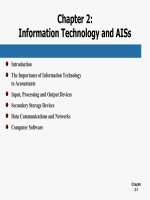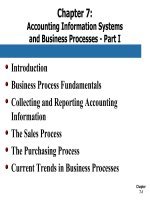Accounting information systems 12th SIMKIN and norman chapter 13
Bạn đang xem bản rút gọn của tài liệu. Xem và tải ngay bản đầy đủ của tài liệu tại đây (410.44 KB, 55 trang )
Chapter 13:
Developing and Implementing Effective
Accounting Information Systems
Introduction
System Development Life Cycle
Systems Planning
Systems Analysis
Detailed Systems Design
Implementation, Follow-Up, and Maintenance
Chapter
13-1
Introduction
Purpose of IT Governance
Ensure
IT is used effectively, efficiently, and
strategically
Study of IT Systems
Planning
and analysis through development
Design, Development, and Implementation
Maintenance of AIS applications
Chapter
13-2
Systems Development
Life Cycle
Systems Study
Systems
Development Work
Formal investigation of an existing information
system
Performance of Study
In-house
professionals (large organizations)
Hire outside consultants (smaller companies)
Chapter
13-3
Four Stages in the Systems
Development Life Cycle
Planning and Investigation
Preliminary
investigation of current system
Organize a systems study team
Develop strategic plans
Analysis of Current System
Identify
information needs
Strengths and weaknesses
Chapter
13-4
Four Stages in the Systems
Development Life Cycle
Design
Changes
that eliminate weak points
Preserve the strengths
Implementation, Follow-up, and Maintenance
Resource
acquisition
Training employees
Identify new problems and correct
Chapter
13-5
Systems Development
Life Cycle
Chapter
13-6
Systems Studies and AISs
Applications Portfolio
Enterprise
system
Specialized information systems for functional areas
Impacts of Systems Studies
Work
flows
Data gathering and recording tasks
Employee responsibilities
Rewards of managers
Chapter
13-7
Study Break #1
Which one of the four stages in the Systems Development Life
Cycle is likely to be most costly for a new system?
A.Planning and Investigation
B.Analysis
C.Design
D.Implementation, Follow-up, and Maintenance
Chapter
13-8
Study Break #1 - Answer
Which one of the four stages in the Systems Development Life
Cycle is likely to be most costly for a new system?
A.Planning and Investigation
B.Analysis
C.Design
D.Implementation, Follow-up, and Maintenance
Chapter
13-9
Systems Planning
Planning for Success
Approach
specific organizational problems from a
broad point of view
Use an interdisciplinary study team for evaluation of
systems
Study team works closely with steering committee
Broad Viewpoint in a Systems Study
Align
study with mission and strategic goals and
objectives
Chapter
13-10
Systems Planning
The Study Team and the Steering Committee
Interdisciplinary
study team
Communicate closely with management
Appoint a steering committee
Investigating Current Systems
Preliminary
investigation to identify issues
Consider alternatives
Make recommendations
Chapter
13-11
Systems Analysis
Purpose
Become
familiar with current system
Identify inputs and outputs
Identify strengths and weaknesses
Make recommendations
Study Team Activities
Identify
and understand system goals
Perform a systems survey
Report findings
Chapter
13-12
Systems Analysis Procedures
Chapter
13-13
Understanding
Organizational Goals
General Systems Goals
Benefits
should exceed the costs
Create output that helps make better decisions
Allows for optimal access to information
Accommodates changing information needs
Chapter
13-14
Understanding
Organizational Goals
Top Management Systems Goals
Long-range
budget planning data
Periodic performance reports
Short-range operating performance
Operating Management Systems Goals
Well-defined
narrow organization areas
Current year decisions
Chapter
13-15
Systems Survey Work
Systems Survey
Allows
for a more complete understanding
Strengths and weaknesses of current system
Understanding the Human Element and
Potential Behavioral Problems
Employee
resistance to change
Gain full cooperation and support
Chapter
13-16
Systems Survey Work
Data Gathering
Review
existing documentation or create new
materials
Observe the current system in operation
Use questionnaires and surveys
Review internal control procedures
Interview systems participants
Chapter
13-17
Systems Survey Questionnaire
Chapter
13-18
Data Analysis
Components
Create
summary statistics
Systems documentation
Time Period
Longer
than preliminary investigation
May provide interim reports
Conclusions
Final
systems analysis report
Submit to steering committee
Chapter
13-19
Evaluating System Feasibility
Technical Feasibility
Required
technical resources
Technical skills of current employees
Operational Feasibility
Compatibility
with current environment
Capabilities of current employees
Chapter
13-20
Evaluating System Feasibility
Schedule Feasibility
Estimate
time needed for implementation
Legal Feasibility
Conflicts
between system and legal obligations
Economic Feasibility
Cost-benefit
analysis
Difficulties estimating implementation costs
Chapter
13-21
Study Break #2
The feasibility evaluation:
A.Is completed prior to detailed systems design
B.Includes economic, schedule, technical, legal, and operational
feasibility
C.Both a and b are true
D.Neither a nor b is true
Chapter
13-22
Study Break #2 - Answer
The feasibility evaluation:
A.Is completed prior to detailed systems design
B.Includes economic, schedule, technical, legal, and operational
feasibility
C.Both a and b are true
D.Neither a nor b is true
Chapter
13-23
Study Break #3
In developing an implementing IT, the study team and steering
committee must consider organizational goals. These include:
A.General, technical, and top management goals
B.General, operating management, and technical goals
C.Top management, operating management, and economic
goals
D.Top management, operating management, and general
systems goals
Chapter
13-24
Study Break #3 - Answer
In developing an implementing IT, the study team and steering
committee must consider organizational goals. These include:
A.General, technical, and top management goals
B.General, operating management, and technical goals
C.Top management, operating management, and economic
goals
D.Top management, operating management, and general
systems goals
Chapter
13-25









